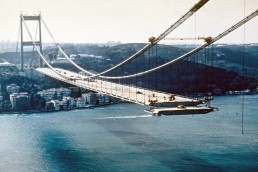Bridge Design Innovations
Dr William Brown was internationally recognised as the leading innovative designer in the field of long-span bridges. His special skills in conceptual design, detail design, fabrication, installation and erection techniques are continually sought after by clients worldwide. His career has presented numerous major design achievements and is synonymous with the evolution of long-span bridge design.
After postgraduate study and research on stiffened plate structures at Imperial College, Dr Brown joined Freeman Fox & Partners, Consulting Engineers, in 1951 as assistant to the late Sir Gilbert Roberts.
Severn Bridge deck design
It was a time for change in steel construction techniques and particularly in steel bridges. Developments in this area were accelerated during the war years and led to a trend away from riveted lattice to welded plate construction. This had greater economic potential, as well as social and industrial benefits. However, knowledge and practical experience were limited. It was here that Dr Brown’s research and design concepts were combined effectively with Sir Gilbert’s experience of welding and his willingness to consider new ideas. They formed an effective team.
When the first major suspension bridge project (over the Forth) was under construction, confidence was building for the use of more modern ideas. Dr Brown’s detailed studies for the deck of the Severn, Wye and other bridges demonstrated many significant advantages both in construction and appearance. Although mathematical analysis for static conditions had indicated possible improvements, dynamic behaviour was less predictable and the need to check the consequences of each design stage by wind tunnel tests had inhibited progress. The shapes intuitively designed by Dr Brown addressed this problem as well.
The resulting design methods, shape and fabrication techniques were a complete departure from the norm and the design, although not accepted universally, has since become a classic of its type. Its form and details are copied worldwide. The design resulted in the first MacRobert Award and Dr Brown’s appointment as an RDI. It confirmed British engineering as the leader in this field.
Bill Brown's Wind Tunnel
Duration: 24:07
This film from the Institution of Civil Engineers (ICE) shows the structural behaviour of different deck designs in Bill Brown’s own wind tunnel. Bill played a key role in the progression of bridge design and innovative features were introduced by him from the 1960s to the 1990s to overcome the challenges of very long-span bridges. He was always looking for new solutions and his breakthrough designs of the aerodynamic box deck for the Severn Bridge, the multi-box deck for the proposed Messina Crossing and the twin-box deck for the Canakkale/ Dardanelles Bridge are all shown in action.
The film is introduced by Nathan Baker, the former ICE Director Engineering Knowledge, and presented by two of Bill Brown’s former colleagues, Dr Stafford Craig and Harvey Binnie.
Excerpts from the film show Bill Brown’s aerodynamically-stable deck designs for the Severn Bridge (1966), proposed Messina Crossing (1996) and the Canakkale Dardanelles Crossing (designed in 1994) being tested in the wind tunnel that Bill used to help develop his innovative solutions.
© Institution of Civil Engineers.





